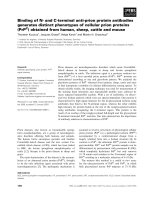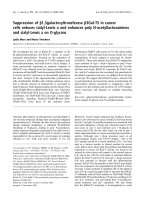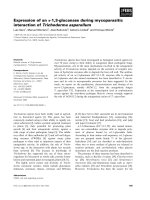Báo cáo khoa hoc:" Expression of estrogen and progesterone receptors in vestibular schwannomas and their clinical significance" docx
Bạn đang xem bản rút gọn của tài liệu. Xem và tải ngay bản đầy đủ của tài liệu tại đây (890.45 KB, 5 trang )
BioMed Central
Page 1 of 5
(page number not for citation purposes)
Journal of Negative Results in
BioMedicine
Open Access
Research
Expression of estrogen and progesterone receptors in vestibular
schwannomas and their clinical significance
Sushila Jaiswal*, Vinita Agrawal, Awadhesh Kumar Jaiswal, Rakesh Pandey
and Ashok Kumar Mahapatra
Address: Department of Pathology and Neurosurgery, Sanjay Gandhi Postgraduate Institute of Medical Sciences, Raebareli Road, Lucknow,
226014, India
Email: Sushila Jaiswal* - ; Vinita Agrawal - ;
Awadhesh Kumar Jaiswal - ; Rakesh Pandey - ; Ashok Kumar Mahapatra -
* Corresponding author
Abstract
Objective: The objective was to determine the expression of estrogen and progesterone
receptors in vestibular schwannomas as well as to determine predictive factors for estrogen and
progesterone receptor positivity.
Materials and methods: The study included 100 cases of vestibular schwannomas operated from
January 2006 to June 2009. The clinical details were noted from the medical case files.
Formaldehyde-fixed parafiin-embedded archival vestibular schwannomas specimens were used for
the immunohistochemical assessment of estrogen and progesterone receptors.
Results: Neither estrogen nor progesterone receptors could be detected in any of our cases by
means of well known immunohistochemical method using well documented monoclonal antibodies.
In the control specimens, a strongly positive reaction could be seen.
Conclusion: No estrogen and progesterone receptor could be found in any of our 100 cases of
vestibular schwannomas. Hence our study does not support a causative role of estrogen and
progesterone in the growth of vestibular schwannoma as well as hormonal manipulation in the
treatment of this tumor.
Introduction
Estrogen and progesterone receptors have been reported
in various human tumors, including endometrial carci-
noma, breast carcinoma, and carcinoma of prostate. They
play a crucial role in the treatment of breast carcinoma.
The presence of these receptors has been examined in a
number of intracranial tumors, in particular in meningi-
omas. It has been suggested that these hormones could be
involved in the development of meningiomas and that
their influence could explain the greater frequency of
meningiomas in women than in men, their increased
growth rate during pregnancy, and their association with
breast cancer [1,2]. Schwannomas are also more frequent,
larger and more vascular in women and increased growth
rate during pregnancy has been described. There are sev-
eral articles on the potential role for the therapeutic
manipulation of estrogen and progesterone receptors in
meningiomas that have not responded to other therapy
[1,2].
Published: 4 November 2009
Journal of Negative Results in BioMedicine 2009, 8:9 doi:10.1186/1477-5751-8-9
Received: 14 July 2009
Accepted: 4 November 2009
This article is available from: />© 2009 Jaiswal et al; licensee BioMed Central Ltd.
This is an Open Access article distributed under the terms of the Creative Commons Attribution License ( />),
which permits unrestricted use, distribution, and reproduction in any medium, provided the original work is properly cited.
Journal of Negative Results in BioMedicine 2009, 8:9 />Page 2 of 5
(page number not for citation purposes)
Vestibular schwannoma also known as acoustic schwan-
noma is the most common cerebellopontine angle tumor
and represents 9% of all brain tumors (Figure 1). Expres-
sion of estrogen and progesterone receptors and their
potential role in the progression of vestibular schwan-
noma is still an area of controversy. Many diverging stud-
ies, using various biochemical and immunohistochemical
methods, have been published on the contents of estro-
gen and progesterone receptors in vestibular schwanno-
mas [3-13]. These studies may help in considering
endocrinological therapy for the vestibular schwannoma
especially in recurrent and residual cases where complete
excision is not feasible.
The objective of the present study was to retrospectively
determine the expression of estrogen and progesterone
receptors by means of immunohistochemical methods
using monoclonal antibodies in 100 cases of vestibular
schwannomas and also to determine predictive factors for
estrogen and progesterone receptor positivity.
Materials and methods
Patient population
This retrospective study included 100 cases of vestibular
schwannomas operated from January 2006 to June 2009
in the Department of Neurosurgery, Sanjay Gandhi Post-
graduate Institute of Medical Sciences, Lucknow, India.
The clinical parameters like age, sex, evidence of cutane-
ous marker for Neurofibroatosis, and menopausal status
were noted from the medical case files. All patients were
operated by suboccipital retrosigmoid approach.
Histopathology and immunohistochemical methods
Formaldehyde-fixed parafiin-embedded archival vestibu-
lar schwannomas specimens from the patients were
obtained from the Department of Pathology, Sanjay Gan-
dhi Postgraduate Institute of Medical Sciences, Lucknow,
India. Five micron thick sections were obtained and the
standard streptavidin biotin peroxidase immunohisto-
chemical method was used for the expression of estrogen
and progesterone receptors. Estrogen receptor (Clone
1D5, Dako, USA) and progesterone receptor (PgR 636,
Dako, USA) monoclonal antibodies were used for the
study. Estrogen and progesterone positive breast tissue
was used as positive control for estrogen and progesterone
receptors. For negative control, primary antibody step was
omitted while performing immunohistochemistry.
Results
Table 1 summarizes the statistical analysis of 100 cases of
vestibular schwannoma included in our study. Out of 100
vestibular schwannoma cases, 63 were males and 37 were
females. Age ranged from 12 years to 77 years (mean age:
37.5 years). Out of 37 females, 28 were premenopausal
and 9 were postmenopausal. None was pregnant at the
time of surgery. Three patients showed cutaneous markers
of Neurofibromatosis. Three patients had bilateral
tumors. Neither estrogen nor progesterone receptors
could be detected in any of our cases by means of well
known immunohistochemical method using well docu-
mented monoclonal antibodies (Figure 2). In the control
Magnetic Resonance (MR) image of vestibular schwannomaFigure 1
Magnetic Resonance (MR) image of vestibular
schwannoma.
Photomicrograph showing vestibular schwannoma with no demonstrable activity with progesterone stainFigure 2
Photomicrograph showing vestibular schwannoma
with no demonstrable activity with progesterone
stain.
Journal of Negative Results in BioMedicine 2009, 8:9 />Page 3 of 5
(page number not for citation purposes)
specimens, a strongly positive reaction could be seen (Fig-
ure 3).
Discussion
Vestibular schwannoma is a benign cerebellopontine
angle tumor and it expresses various hormone receptors
for examples estrogen, progesterone, androgen, somato-
statin and glucocorticoid. The clinical significance of these
receptors is that they play a possible role in tumor growth
[7,14]. Studies on the expression of estrogen and proges-
terone receptors in vestibular schwannomas have seldom
been reported. Moreover, conflicting results about the
expression of estrogen and progesterone receptors in ves-
tibular schwannomas have been reported in the literature.
The level of expression has ranged from all tumor speci-
mens being negative to 100% being positive for progester-
one receptor. For estrogen receptor the level of expression
ranged from all tumors being negative to 44% being pos-
itive [2-12]. Table 2 summarizes the details of these stud-
ies. These discrepancies are probably due to the divergent
methodologies which have been used by various authors
ranging from ligand binding studies and immunohisto-
chemical methods to molecular techniques like polymer-
ase chain reaction and Northern blot analysis. Positivity
of estrogen and progesterone receptors in vestibular
schwannomas has clinical significance as antiestrogen
and/or antiprogesterone therapy may be considered as an
adjunct treatment modality in vestibular schwannomas
particularly in cases having small residual tumor follow-
ing surgical excision.
Kasantikul and Brown [6] analyzed a series of 103 vestib-
ular shwannomas and found that tumor occurred with
greater frequency in women (58%), and that of 88
medium, large, and giant tumors, 64% occurred in
women. Of 15 small tumors, 73% occurred in men. More-
over, tumors in women were more vascular. They per-
formed a quanlitative immunofluorescence
histochemical staining to detect estrogen-binding activity
and found 1 of 8 tumors had estrogen-binding activity
and the intensity of the staining was found to be much
greater in the tumors from the 5 women. They concluded
that estrogen may promote the growth of acoustic
schwannomas by inducing proliferation of vascular
endothelium, with a resultant increase in tumor vascular-
ity. Monsell and Wiet [3] studied 37 cases of vestibular
schwannomas for estrogen and progesterone receptors by
radioimmunoassay and found that 19% of cases were
positive for estrogen receptor, 17% cases were positive for
progesterone receptors and 8% cases were positive for
both the receptors. There was no correlation of estrogen
receptor positivity with the sex of the patient. These results
indicate that estrogen or progesterone receptor binding
activity or both are present in a small subset of vestibular
schwannomas. Evidence is lacking, however, that binding
of estrogen to the receptor results in the growth changes in
the tumor. Siglock et al [10] performed quantitative assays
for estrogen, progesterone and testosterone receptors in
19 cases (10 male, 9 females) of vestibular schwannomas
and found that 3 of 10 men and 7 of 9 women tumors
were positive for progesterone receptors. All tumor speci-
mens were positive for estrogen or testosterone receptors.
He concluded there is need for further investigations of
endocrinologic therapy as a possible treatment of acoustic
neuroma. Cafer et al [11] analyzed presence of Ki-67, and
estrogen and progesterone hormone receptors as well as
their clinical correlates in 59 cases of vestibular schwan-
nomas. On immunohistochemistry, all samples were pos-
itive for progesterone receptor and negative for estrogen
receptor staining. Ki-67 staining was encountered in 34 of
59 (57.6%) patients, and Ki-67 values ranged from 0 per
cent to 10.9 per cent (mean 1.36 per cent). There was no
correlation between Ki-67, gender, tumour size and symp-
toms of the patients (p > 0.05). The authors concluded
that oestrogen is not an important hormone in acoustic
neuroma due to the absence of oestrogen receptor expres-
sion in the tissue samples. Since the progesterone receptor
was expressed in all acoustic neuroma samples, they advo-
cated further studies to find out about the inhibitory effect
of antiprogesterone treatment on acoustic neuroma
growth, which may be important particularly in elderly
people or high-risk patients. Although Ki-67 was
expressed in the majority of acoustic neuromas, it was not
found an important marker in clinical practice due to a
lack of any correlation with the clinical parameters. Car-
roll et al [6] studied expression of androgen, progesterone
glucocorticoid and estrogen receptor messenger ribonu-
cleic acid levels (mRNA) in 21 cases of vestibular schwan-
nomas by either Northern blot analysis or the polymerase
Photomicrograph showing breast tissue with strong expres-sion of progesterone receptorsFigure 3
Photomicrograph showing breast tissue with strong
expression of progesterone receptors.
Journal of Negative Results in BioMedicine 2009, 8:9 />Page 4 of 5
(page number not for citation purposes)
chain reaction (PCR) and demonstrated that glucocorti-
coid receptor mRNA was expressed in 100% of the cases.
Only two male specimens were positive for androgen
receptor mRNA expression by PCR-Southern blot analy-
sis. Thirty-three percent of the schwannomas (7/21)
showed a strong band for progesterone receptor mRNA by
PCR-Southern blot analysis; there were an equal number
of males and females in this group. Estrogen receptor
mRNA levels were undetectable in all tumors examined by
PCR-Southern blot analysis. They suggested that the pat-
tern of steroid receptor expression is different in schwan-
nomas than in meningiomas. Individual vestibular
schwannoma needs to be examined for their steroid
receptor mRNA expression to know whether they are
responsive. Beatty et al [5] studied 24 cases of vestibular
schwannomas using immunohistochemical staining and
noted that estrogen receptors were positive in 6 cases and
progesterone receptors were positive in 11 cases. Labit-
Bouvier et al [12] analyzed 69 cases of vestibular schwan-
nomas by immunohistochemical methods and found
Table 1: Statistical analysis of 100 cases of vestibular schwannomas
Parameters Number of cases Percentage
Males 63 63
Females 37 37
Premenopausal females 28 28
Postmenopausal females 9 9
Pregnant females 0 0
Bilateral vestibular schwannomas 3 3
Presence of cutaneous markers of Neurofibromatosis 3 3
Table 2: Summary of reported series of expression of estrogen and progesterone receptors in vestibular schwannomas
Sl no. Author Year No. of cases ER positivity (%) PR positivity (%)
1 Kasantikul et al 1981 20 20 60
2 Markwalder et al 1986 16 44 Not studied
3 Monsell and Wiet 1990 37 19 17
4 Siglock et al 1990 19 100 52
5 Klinken et al 1990 18 none none
6 Curley et al 1990 14 none none
7 Beatty et al 1995 24 25 50
8 Carroll et al 1997 21 none 33
9 Labit-Bouvier et al 2000 69 none 10
10 Cafer et al 2008 59 none 100
11 Dalgorf et al 2008 9 none none
12 Jaiswal et al 2009 100 none none
Publish with BioMed Central and every
scientist can read your work free of charge
"BioMed Central will be the most significant development for
disseminating the results of biomedical research in our lifetime."
Sir Paul Nurse, Cancer Research UK
Your research papers will be:
available free of charge to the entire biomedical community
peer reviewed and published immediately upon acceptance
cited in PubMed and archived on PubMed Central
yours — you keep the copyright
Submit your manuscript here:
/>BioMedcentral
Journal of Negative Results in BioMedicine 2009, 8:9 />Page 5 of 5
(page number not for citation purposes)
that 7 out of 69 were positive for estrogen receptors and
none were positive for estrogen receptor.
Curley et al [8] studied 14 cases (8 males, 6 females) of
vestibular schwannoma for expression of estrogen and
progesterone receptors. No unequivocal positive result
was noted in his study. Klinken et al [4] used immunohis-
tochemical method and did not find estrogen and proges-
terone receptor positivity in any of his 18 cases (7 male,
11 females) of vestibular schwannomas. In a recent study
by Dalgorf et al [13], 9 females with vestibular schwan-
noma were studied for expression of estrogen, progester-
one and vascular endothelial growth factor (VEGF) by
immunohistochemical studies using monoclonal mouse
antibodies and their result for estrogen and progesterone
receptor was unequivocally negative in all the nine cases
while VEGF was positive in eight out of nine cases. Sup-
porting these three studies, our study also did not demon-
strate estrogen and progesterone receptors positivity in
any of 100 vestibular schwannomas cases although the
number of cases in our study was much higher than these
studies.
Conclusion
This study demonstrated no evidence to support the clin-
ical hypothesis that vestibular schwannomas might be
hormone dependent tumours. The methods of assay used
were both specific and sensitive. No estrogen and proges-
terone receptor could be found in any of our 100 cases of
vestibular schwannoma. Hence our study does not sup-
port a causative role of estrogen and progesterone in the
growth of vestibular schwannoma as well as hormonal
manipulation in the treatment of this tumor.
Competing interests
The authors declare that they have no competing interests.
Authors' contributions
SJ: Principal investigator - did the study, collected data
and wrote the paper; VA: Co-investigator - helped in doing
the study and collecting the data; AKJ: Co-investigator -
collected the articles; RP: Co-investigator - provided the
advice and coordinated the study; AKM: Co-investigator -
gave the idea and advice for the study.
Acknowledgements
The authors are thankful to Mr. R. K. Vishwakarma and Mr. M. C. Upriti,
Laboratory Technicians, Department of Pathology, Sanjay Gandhi Postgrad-
uate Institute of Medical Sciences, Lucknow, India for performing immuno-
histochemistry on the surgical specimens.
References
1. Carroll RS, Zhang J, Dashner K, Sar M, Black PM: Steroid hormone
receptors in astrocytic neoplasms. Neurosurgery 1995,
37:496-504.
2. Whittle IR, Hawkins RA, Miller JD: Sex hormone receptors in
intracranial tumors and normal brain. Eur J Surg Oncol 1987,
13:303-307.
3. Monsell EW, Wiet RJ: Estrogen and progesterone binding in
acoustic neuroma tissue. Otolaryngol Head Neck Surg 1990,
103:377-379.
4. Klinken L, Thomsen J, Rasmussen BB, Wiet RJ, Tos M: Estrogen and
progesterone receptors in acoustic neuromas. Arch Otolaryngol
Head Neck Surg 1990, 116:202-204.
5. Beatty CW, Scheithauer BW, Katzmann JA, Roche PC, Kjeldahl KS,
Ebsersold MJ: Acoustic schwannomas in pregnancy: a DNA
flow cytometric, steroid hormone receptor and proliferation
marker study. Laryngoscope 1995, 105:693-700.
6. Kanasantikul V, Brown WJ: Estrogen receptors in acoustic neu-
rilemmomas. Surg Neurol 1981, 15:105-109.
7. Carroll RS, Zhang JP, Black PML: Hormone receptors in vestibu-
lar schwannomas. Acta Neurochir (Wien) 1997, 139:188-193.
8. Curley JW, Ramsden RT, Howell A, Healy K, Lye RH: Oestrogen
and progesterone receptors in acoustic neuroma. J Laryngol
Otol 1990, 104:865-867.
9. Markwalder TM, Waelti E, Markwalder RV: Estrogen and proges-
tin receptors in acoustic and spinal neurilemmonas. Surg neu-
rol 1986, 26:142-148.
10. Siglock TJ, Rosenblatt SS, Finck F, House WF, Hitselberger WE: Sex
hormone receptors in acoustic neuromas. Am J Otol 1990,
11:327-239.
11. Cafer S, Bayramoglu I, Uzum N, Memis L, Uygur K: Expression and
clinical significance of Ki-67, oestrogen and progesterone
receptors in acoustic neuroma. J Laryngol Otol
2008,
122:125-127.
12. Labit-Bouvier C, Crebassa B, Bouvier C, Andrac-Meyer L, Magna J,
Charpin C: Clinicopathological growth factors in vestibular
schwannomas: a morphological and immunohistochemical
study of 69 tumors. Acta Otolaryngol 2000, 120:950-954.
13. Dalgorf DM, Rowsell C, Bilbao JM, Chen JM: Immunohistochemi-
cal investigation of hormonal receptors and vascular
endothelial growth factor concentration in vestibular
schwannoma. Skull Base 2008, 18:377-384.
14. Stafford ND, Condon LT, Rogers MJC, Helboe L, Crooks DA, Atkins
SL: The immunohistochemical localization of somatostatin
receptors 1,2,3 and 5 in acoustic neuromas. J Clin Pathol 2004,
57:168-171.









